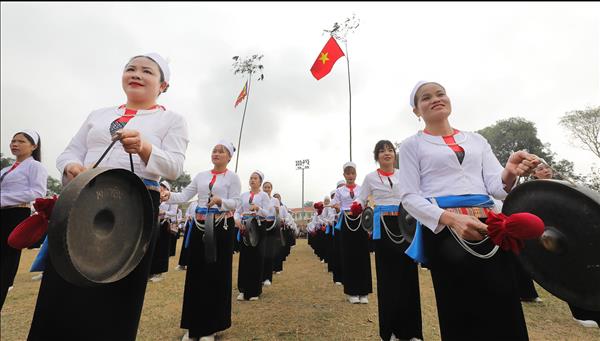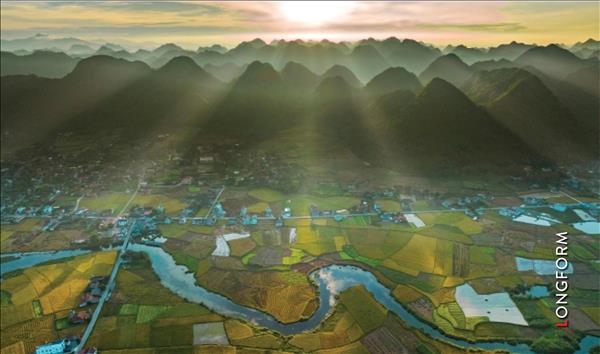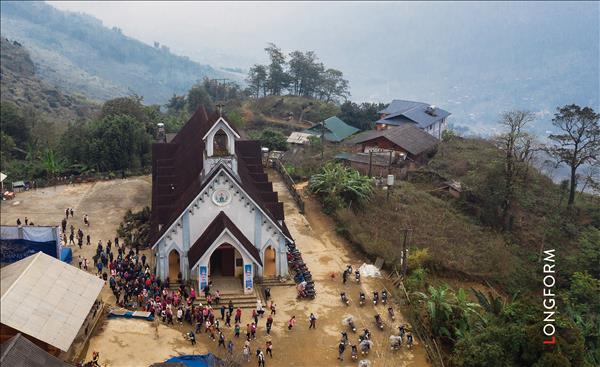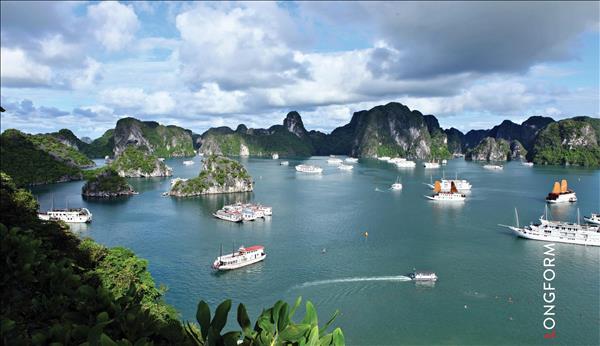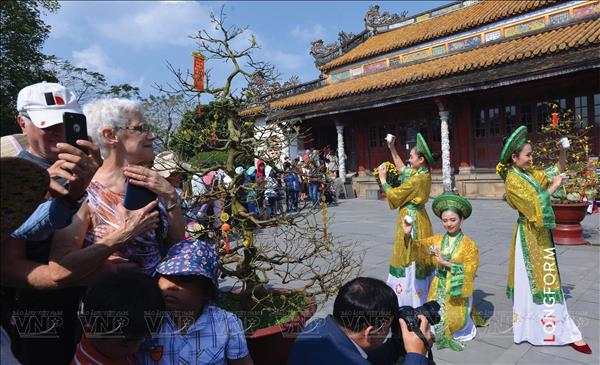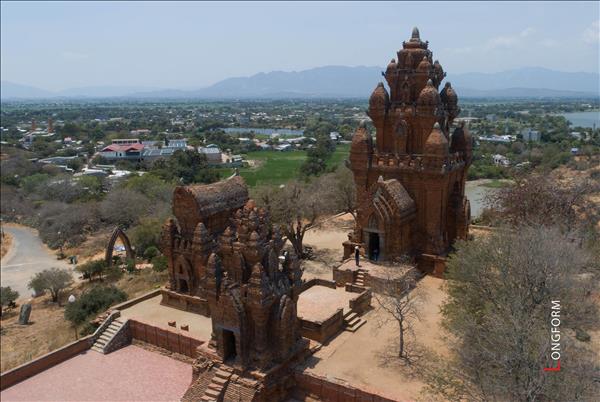The ballad of mountain clearance
The north-western people’s legendary story goes that some four centuries ago, such ethnic people like the Mong, Dao and La Chi migrated to the north-western region to claim the virgin land and settle down. Yet, by then, the four big valleys of the north-western region, including Muong Thanh (Dien Bien Province), Muong Lo (Yen Bai Province), Muong Than (Lai Chau Province) and Muong Tac (Son La Province), were already inhabited by the local ethnic groups of Thai and La Ha. As a result, the former had to choose such mountain ranges as Khau Pha (Mu Cang Chai-Yen Bai), Hoang Lien Son (Sa Pa-Lao Cai) and Tay Con Linh (Hoang Su Phi-Ha Giang), which are 1,000m-1,600m above sea level, as their new settlements to build their own hamlets.
To ensure their livelihood, these ethnic people had to opt for the cultivation of maize and milpa rice on highly slanted mountains for their daily food. Initially, the terraced fields were built at the foot of the mountain near water sources for irrigation. Later, when their population grew, these ethnic minorities developed their fields higher and higher on the mountain slopes, thus creating beautiful terraced fields around the mountains which can be seen today.
Terraced field building was truly an elaborate process, using the great minds and energy of the new settlers. Cu A Giang of the Mong in La Pan Tan Commune (Mu Cang Chai) told us, “With our forefathers’ experience, the mountains selected for terraced field building had to be slightly slanted with water sources from streams and structured with fewer stones and rocks for easy creation of flat cultivation ground. Terraced field building was usually conducted in spring from January to March so that from April thru May, water could be collected for the timely service of farming”.
Meanwhile, Ly Van Trach in Thung Nguyen Commune (Hoang Su Phi) revealed that the most difficult tasks in terraced field building were ground levelling and field embankment, which were really essential for water storage and water flow throughout the whole field. He explained: “Our Dao people often use hoses and footings for field embankment. The uneven level between the upper and lower fields is 0.5m - 2m. Field banks made of earth gradually turn hard when they are soaked with water brought into the fields.”
Virgin land reclamation was carried on from year to year and generation to generation, thus making terraced fields like great frescoes on mountain slopes. Terraced field development is closely associated with the residence history and culture of the Mong, Dao, La Chi and Nung ethnic groups in Mu Cang Chai, Hoang Su Phi and Sa Pa. Because these ethnic minorities in their spiritual life think that all things exist in holy forms, terraced fields, working instruments and paddys are consecrated as deities such as the field deity, rice deity, thunder deity and water deity.
Such poly-deity imprints are clearly manifested through the customary worship of the working instrument deity, field deity and water deity in the Mong ethos’s New Year festival held in the twelfth lunar month. Giang A Chu in Cao Pha Commune (Mu Cang Chai) explained, “As the hoses and the ploughs toil strenuously all year round, helping us turn up and plough the soil for production of rice and maize, they must take a rest during the New Year festival. Hence, our people maintain the practice of sticking paper on ploughs and hoses and put them on altars to worship, burning incense to express our gratitude as we do to our ancestors”.
Similarly, there still exists among the red Dao community in Hoang Su Phi District a fairly strange ritual to worship the rice paddy spirit. The red Dao ethnic groups believe that paddies on terraced fields also exist in the soul and body like people. Mountain sorcerer Trieu Choi Hin, who presided over the paddy spirit-worshipping ritual this year in Ho Thau Commune, revealed, “In the process of gathering rice from terraced fields, numerous grains were dropped on the fields or when being transported. Our Dao people must hold rituals to conjure up the souls of such grains so that the next crops will not fail and more and more rice will be brought home”.
Related to poly-deity belief around the terraced field, the Dao, Mong, La Chi and Nung ethic people living in Tay Con Linh mountain region have, so far, still maintained their belief in the story of Thunder deity worship in Suoi Thau Hamlet, Ban Luoc Commune. The hamlet chief Dang Hong Canh said that some 300 years ago the long-dress wearing Dao people came to build terraced fields in this area, but their crops failed due to the absence of rains. Yet, since they built a temple worshipping the Thunder deity, their farming has gone well in good weather. Therefore, nowadays when a new harvest begins, people in Hoang Su Phi congregate at the holy temple to pray for rain.
Terraced fields of prosperity
Giang A Tong, Chairman of Mu Cang Chai District People’s Committee, who was born and grew up on the Khau Pha mountain range, is proud of his native place being a famous landscape: “From the time of our forefathers, terraced fields became a source of our livelihood. The Mong people have, generation after generation, constantly built new terraced fields. Since 2007 when Mu Cang Chai terraced field was recognised by the Ministry of Culture, Sports and Tourism as a national landscape, it has become a common property, which not only yields rice but also constitutes the Mong people’s identity, which should be preserved”.
The hamlet chief also revealed that in recent years, the Mong and Thai people in Mu Cang Chai District have applied scientific advances to terraced field farming with the average rice yield of 5.3tons/ha. In 2014 alone, the total rice output of Mu Cang Chai District reached nearly 27,000tons, contributing to local food security.
The terraced fields in three communes of Che Cu Nha, La Pan Tan and De Xu Phinh have become attractive places for visitors who come to see the splendid beauty of waterfalls and rice harvests. Annually, the terraced field ritual is organised during the rice-harvest to promote tourism. Giang A Tong said with pride: “The terraced field ritual is actually a rite to honour the local inhabitants who have shed their sweat, tears and even blood to create the terraced fields of happiness and prosperity in this highland region”.
In Hoang Su Phi, the terraced fields came into being 3-4 centuries ago. They are located in the communes of Ban Luoc, San Sa Ho, Ban Phung, Ho Thau, Nam Ty and Thong Nguyen. The Ministry of Culture, Sports and Tourism has officially recognised 760ha out of a total of more than 3,000ha of terraced fields in Hoang Su Phi as national relics.
Hoang Hai Ly, Secretary of the Hoang Su Phi District Party Committee, revealed that each year, the local terraced fields yield 25,000 – 27,000tons of rice, contributing to ensure the food security for more than 60,000 district dwellers.
During the Cultural Week of Terraced Field Tourism held recently in September, the HELVETAS project of Sweden committed an investment of five billion dong as support for the Hoang Su Phi people to develop a form of homestay tourism in order to attract foreign visitors to locations with well-known terraced fields in the district such as Nam Ty, Thong Nguyen, Ban Phung and Bac Luoc. Homestay tourism is expected to open up a bright future for Hoang Su Phi inhabitants to introduce to foreign visitors the beauty, culture and beliefs related to the scenic terraced fields on Tay Con Linh mountain range.
Meanwhile in Sa Pa (Lao Cai Province), the development and expansion of terraced fields in Muong Hoa Valley comprised of the communes of Ta Van, Lao Chai and Hau Thao have long been a local undertaking to ensure food security, putting an end to nomadic farming and the life which was a struggle in the locality. So far, nearly 2,500ha of terraced fields have been developed in Sa Pa District, with an average yield of nearly 4.6tons/ha and an annual rice output of some 120,000tons.
The terraced fields stretching over hundreds of hectares, which have been industriously created by various ethnic people in Sa Pa as a “giant fresco” was selected by American magazine “Travel and Leisure” as one of seven most beautiful terraced fields in the world. This spot is currently a place for the mountain district of Sa Pa to develop tourism and its economy. In 2014 alone, Sa Pa welcomed 1.5 million visitors with a total revenue of over 28,000 billion dong.
Hoang Hai Ly, Secretary of the Hoang Su Phi District Party Committee, revealed that each year, the local terraced fields yield 25,000 – 27,000tons of rice, contributing to ensure the food security for more than 60,000 district dwellers.
During the Cultural Week of Terraced Field Tourism held recently in September, the HELVETAS project of Sweden committed an investment of five billion dong as support for the Hoang Su Phi people to develop a form of homestay tourism in order to attract foreign visitors to locations with well-known terraced fields in the district such as Nam Ty, Thong Nguyen, Ban Phung and Bac Luoc. Homestay tourism is expected to open up a bright future for Hoang Su Phi inhabitants to introduce to foreign visitors the beauty, culture and beliefs related to the scenic terraced fields on Tay Con Linh mountain range.
Meanwhile in Sa Pa (Lao Cai Province), the development and expansion of terraced fields in Muong Hoa Valley comprised of the communes of Ta Van, Lao Chai and Hau Thao have long been a local undertaking to ensure food security, putting an end to nomadic farming and the life which was a struggle in the locality. So far, nearly 2,500ha of terraced fields have been developed in Sa Pa District, with an average yield of nearly 4.6tons/ha and an annual rice output of some 120,000tons.
The terraced fields stretching over hundreds of hectares, which have been industriously created by various ethnic people in Sa Pa as a “giant fresco” was selected by American magazine “Travel and Leisure” as one of seven most beautiful terraced fields in the world. This spot is currently a place for the mountain district of Sa Pa to develop tourism and its economy. In 2014 alone, Sa Pa welcomed 1.5 million visitors with a total revenue of over 28,000 billion dong.
The scenic terraced fields in the northwestern region have constituted not only a fantastic natural picture but also an epic wonder of creative labour of the highlanders in the course of several centuries of transforming nature to serve their lives.
To ensure their livelihood, these ethnic people had to opt for the cultivation of maize and milpa rice on highly slanted mountains for their daily food. Initially, the terraced fields were built at the foot of the mountain near water sources for irrigation. Later, when their population grew, these ethnic minorities developed their fields higher and higher on the mountain slopes, thus creating beautiful terraced fields around the mountains which can be seen today.
Terraced field building was truly an elaborate process, using the great minds and energy of the new settlers. Cu A Giang of the Mong in La Pan Tan Commune (Mu Cang Chai) told us, “With our forefathers’ experience, the mountains selected for terraced field building had to be slightly slanted with water sources from streams and structured with fewer stones and rocks for easy creation of flat cultivation ground. Terraced field building was usually conducted in spring from January to March so that from April thru May, water could be collected for the timely service of farming”.
Meanwhile, Ly Van Trach in Thung Nguyen Commune (Hoang Su Phi) revealed that the most difficult tasks in terraced field building were ground levelling and field embankment, which were really essential for water storage and water flow throughout the whole field. He explained: “Our Dao people often use hoses and footings for field embankment. The uneven level between the upper and lower fields is 0.5m - 2m. Field banks made of earth gradually turn hard when they are soaked with water brought into the fields.”
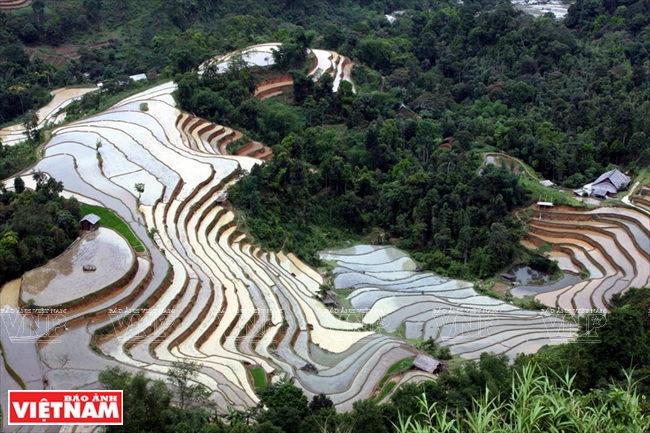 The terraced field in Nam Ty Commune is among the most beautiful fields in Hoang Su Phi District (Ha Giang Province). Photo: Nguyen Thang/VNP  Ta Van Valley in Sa Pa Town attracts visitors with its primitive natural landscape and mesmerizing terraced fields embracing villages. Photo: Nguyen Thang/VNP 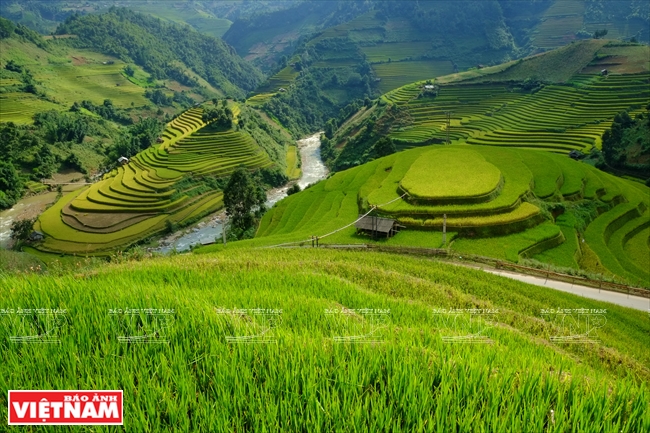 Terraced rice fields that look like trays of steamed sticky rice or shoe soles during ripe season in Che Cu Nha Commune, Mu Cang Chai Disitrct. Photo: Nguyen Thang/VNP 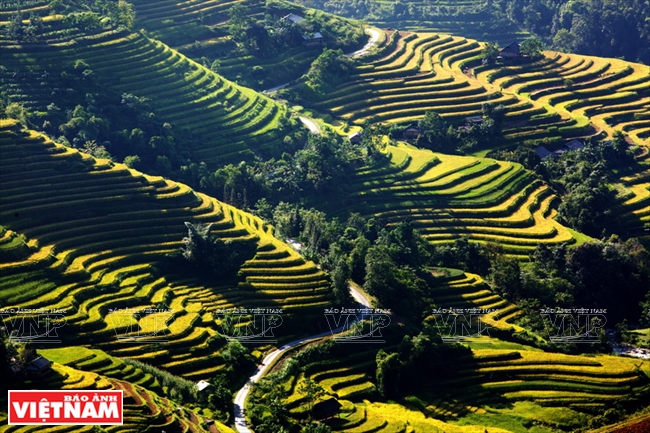 Terraced rice fields during the harvest in Ban Luoc Commune (Hoang Su Phi). Photo: Thong Thien/VNP 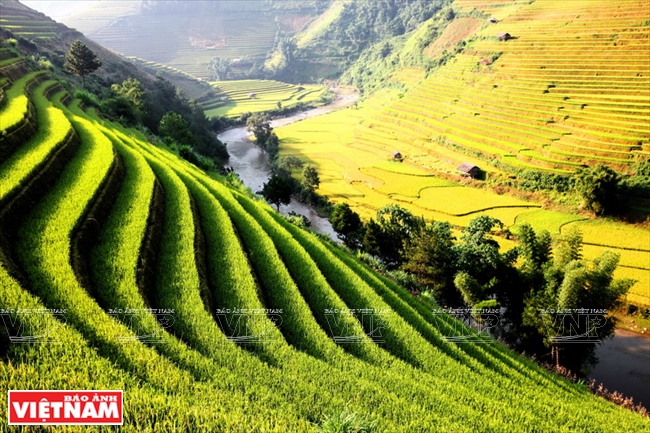 During the rice harvest, terraced fields in Che Cu Nha Commune (Mu Cang Chai District, Yen Bai Province) form rolling waves rising to the peak of the mountain. Photo: Nguyen Thang/VNP |
| The terraced field acreage in the north-west is currently estimated at some ten thousand hectares, including nearly 2,200ha in Mu Cang Chai District, nearly 765ha in Hoang Su Phi District and nearly 1,000ha in Sa Pa, which have been recognised by the state as national landscapes. |
Such poly-deity imprints are clearly manifested through the customary worship of the working instrument deity, field deity and water deity in the Mong ethos’s New Year festival held in the twelfth lunar month. Giang A Chu in Cao Pha Commune (Mu Cang Chai) explained, “As the hoses and the ploughs toil strenuously all year round, helping us turn up and plough the soil for production of rice and maize, they must take a rest during the New Year festival. Hence, our people maintain the practice of sticking paper on ploughs and hoses and put them on altars to worship, burning incense to express our gratitude as we do to our ancestors”.
Similarly, there still exists among the red Dao community in Hoang Su Phi District a fairly strange ritual to worship the rice paddy spirit. The red Dao ethnic groups believe that paddies on terraced fields also exist in the soul and body like people. Mountain sorcerer Trieu Choi Hin, who presided over the paddy spirit-worshipping ritual this year in Ho Thau Commune, revealed, “In the process of gathering rice from terraced fields, numerous grains were dropped on the fields or when being transported. Our Dao people must hold rituals to conjure up the souls of such grains so that the next crops will not fail and more and more rice will be brought home”.
Related to poly-deity belief around the terraced field, the Dao, Mong, La Chi and Nung ethic people living in Tay Con Linh mountain region have, so far, still maintained their belief in the story of Thunder deity worship in Suoi Thau Hamlet, Ban Luoc Commune. The hamlet chief Dang Hong Canh said that some 300 years ago the long-dress wearing Dao people came to build terraced fields in this area, but their crops failed due to the absence of rains. Yet, since they built a temple worshipping the Thunder deity, their farming has gone well in good weather. Therefore, nowadays when a new harvest begins, people in Hoang Su Phi congregate at the holy temple to pray for rain.
Terraced fields of prosperity
Giang A Tong, Chairman of Mu Cang Chai District People’s Committee, who was born and grew up on the Khau Pha mountain range, is proud of his native place being a famous landscape: “From the time of our forefathers, terraced fields became a source of our livelihood. The Mong people have, generation after generation, constantly built new terraced fields. Since 2007 when Mu Cang Chai terraced field was recognised by the Ministry of Culture, Sports and Tourism as a national landscape, it has become a common property, which not only yields rice but also constitutes the Mong people’s identity, which should be preserved”.
The hamlet chief also revealed that in recent years, the Mong and Thai people in Mu Cang Chai District have applied scientific advances to terraced field farming with the average rice yield of 5.3tons/ha. In 2014 alone, the total rice output of Mu Cang Chai District reached nearly 27,000tons, contributing to local food security.
|
Mong ethnic women in Mu Cang Chai District form the field banks and weed to prepare for a new growing season. Photo: Hoang Ha/VNP 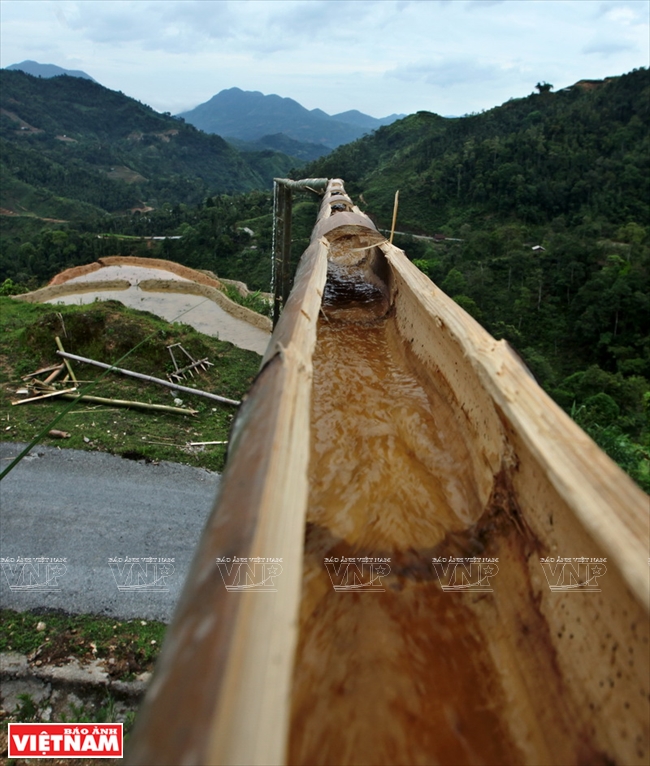 Mong, Dao, Tay, Nung, La Chi ethnic people make water pipes from bamboo poles to divert water from streams to fields or from higher fields to lower ones. Photo: Cong Dat/VNP  Mong people in Mu Cang Chai District often start transplanting rice seedlings in May or June. Photo: Tat Son/VNP Ho Thi De in De Thang Hamlet, Che Cu Nha Commune (Mu Cang Chai) says that harvested rice will be sun-dried in the field for three days before being threshed to remove the stalks and delivered to houses. Photo: Tat Son/VNP After harvesting rice, Nung people in Po Lo Commune (Hoang Su Phi, Ha Giang) use mangers to thresh rice in the fields. Photo: Thong Thien/VNP Nowadays, the Nung people in Po Lo Commune (Hoang Su Phi) still keep the custom of exchanging labour during the harvest season. Photo: Thong Thien/VNP Baskets full of golden rice represent the wealth of ethnic people in the Northwest. Photo: Tat Son/VNP |
In Hoang Su Phi, the terraced fields came into being 3-4 centuries ago. They are located in the communes of Ban Luoc, San Sa Ho, Ban Phung, Ho Thau, Nam Ty and Thong Nguyen. The Ministry of Culture, Sports and Tourism has officially recognised 760ha out of a total of more than 3,000ha of terraced fields in Hoang Su Phi as national relics.
Hoang Hai Ly, Secretary of the Hoang Su Phi District Party Committee, revealed that each year, the local terraced fields yield 25,000 – 27,000tons of rice, contributing to ensure the food security for more than 60,000 district dwellers.
During the Cultural Week of Terraced Field Tourism held recently in September, the HELVETAS project of Sweden committed an investment of five billion dong as support for the Hoang Su Phi people to develop a form of homestay tourism in order to attract foreign visitors to locations with well-known terraced fields in the district such as Nam Ty, Thong Nguyen, Ban Phung and Bac Luoc. Homestay tourism is expected to open up a bright future for Hoang Su Phi inhabitants to introduce to foreign visitors the beauty, culture and beliefs related to the scenic terraced fields on Tay Con Linh mountain range.
Meanwhile in Sa Pa (Lao Cai Province), the development and expansion of terraced fields in Muong Hoa Valley comprised of the communes of Ta Van, Lao Chai and Hau Thao have long been a local undertaking to ensure food security, putting an end to nomadic farming and the life which was a struggle in the locality. So far, nearly 2,500ha of terraced fields have been developed in Sa Pa District, with an average yield of nearly 4.6tons/ha and an annual rice output of some 120,000tons.
The terraced fields stretching over hundreds of hectares, which have been industriously created by various ethnic people in Sa Pa as a “giant fresco” was selected by American magazine “Travel and Leisure” as one of seven most beautiful terraced fields in the world. This spot is currently a place for the mountain district of Sa Pa to develop tourism and its economy. In 2014 alone, Sa Pa welcomed 1.5 million visitors with a total revenue of over 28,000 billion dong.
| The Mong and Thai people in Mu Cang Chai District have applied scientific advances to terraced field farming with the average rice yield of 5.3tons/ha. In 2014 alone, the total rice output of Mu Cang Chai District reached nearly 27,000tons, contributing to local food security. |
Hoang Hai Ly, Secretary of the Hoang Su Phi District Party Committee, revealed that each year, the local terraced fields yield 25,000 – 27,000tons of rice, contributing to ensure the food security for more than 60,000 district dwellers.
During the Cultural Week of Terraced Field Tourism held recently in September, the HELVETAS project of Sweden committed an investment of five billion dong as support for the Hoang Su Phi people to develop a form of homestay tourism in order to attract foreign visitors to locations with well-known terraced fields in the district such as Nam Ty, Thong Nguyen, Ban Phung and Bac Luoc. Homestay tourism is expected to open up a bright future for Hoang Su Phi inhabitants to introduce to foreign visitors the beauty, culture and beliefs related to the scenic terraced fields on Tay Con Linh mountain range.
Meanwhile in Sa Pa (Lao Cai Province), the development and expansion of terraced fields in Muong Hoa Valley comprised of the communes of Ta Van, Lao Chai and Hau Thao have long been a local undertaking to ensure food security, putting an end to nomadic farming and the life which was a struggle in the locality. So far, nearly 2,500ha of terraced fields have been developed in Sa Pa District, with an average yield of nearly 4.6tons/ha and an annual rice output of some 120,000tons.
The terraced fields stretching over hundreds of hectares, which have been industriously created by various ethnic people in Sa Pa as a “giant fresco” was selected by American magazine “Travel and Leisure” as one of seven most beautiful terraced fields in the world. This spot is currently a place for the mountain district of Sa Pa to develop tourism and its economy. In 2014 alone, Sa Pa welcomed 1.5 million visitors with a total revenue of over 28,000 billion dong.
|
The Red Dao people in Ho Thau Commune (Hoang Su Phi) pray for the Deity of Rice. Photo: Thong Thien/VNP A sorcerer conducts the ritual to call the spirit of rice. Photo: Thong Thien/VNP Sorcerer Trieu Choi Hin in Ho Thau Commune (Hoang Su Phi) blows a horn to call the spirit of rice. Photo: Thong Thien/VNP The Red Dao people in Hoang Su Phi District believe that the spirit of each grain of rice can call 1,000 grains to their baskets, resulting in measureless rice for people. Photo: Thong Thien/VNP 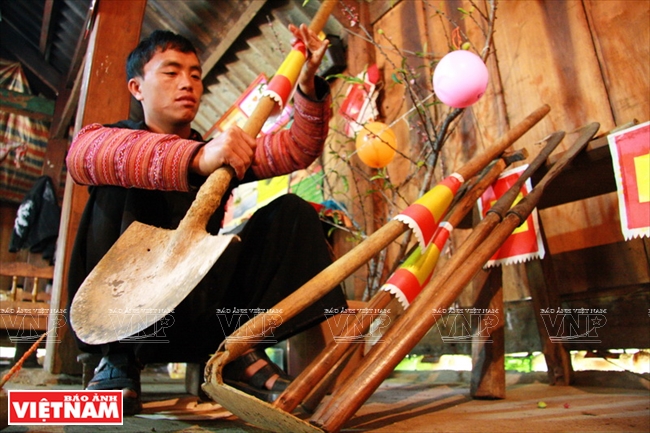 During Tet Holiday, the Mong people often attach colourful paper to their farming implements to express their thanks for the tools that help them produce food. Photo: Thong Thien/VNP |
The scenic terraced fields in the northwestern region have constituted not only a fantastic natural picture but also an epic wonder of creative labour of the highlanders in the course of several centuries of transforming nature to serve their lives.
Story: THONG THIEN
Photos: NGUYEN THANG, HOANG HA, THONG THIEN, TAT SON & CONG DAT
Photos: NGUYEN THANG, HOANG HA, THONG THIEN, TAT SON & CONG DAT
phamtrangnhung

